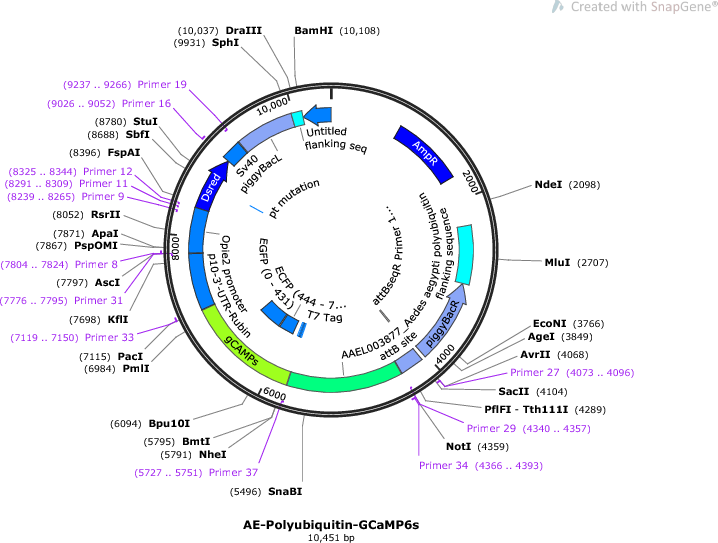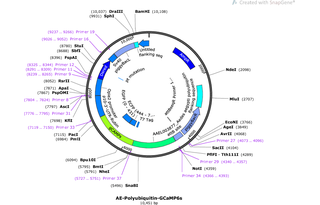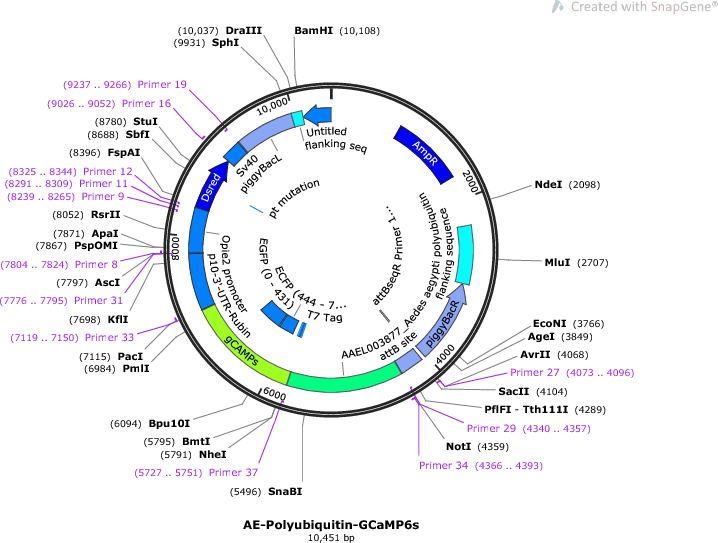AE-Polyubiquitin-GCaMP6s
(Plasmid
#106868)
-
PurposeExpresses polyubiquitin GCaMP6s, a genetically encoded calcium indicator, for live calcium imaging in Aedes aegypti mosquitoes.
-
Depositing Lab
-
Sequence Information
Ordering
| Item | Catalog # | Description | Quantity | Price (USD) | |
|---|---|---|---|---|---|
| Plasmid | 106868 | Standard format: Plasmid sent in bacteria as agar stab | 1 | $85 | |
This material is available to academics and nonprofits only.
Backbone
-
Vector backbonePiggyBac
- Backbone size w/o insert (bp) 5246
- Total vector size (bp) 6599
-
Vector typeInsect Expression
Growth in Bacteria
-
Bacterial Resistance(s)Ampicillin, 100 μg/mL
-
Growth Temperature37°C
-
Growth Strain(s)DH5alpha
-
Copy numberUnknown
Gene/Insert
-
Gene/Insert nameAE-Polyubiquitin-GCAaMP6s
-
SpeciesR. norvegicus (rat)
-
Insert Size (bp)1353
- Promoter Ae. aegypti polyubiquitin (PUb)
Cloning Information
- Cloning method Gibson Cloning
- 5′ sequencing primer CGACGGTCACGGCGGGCATGTCGACGCGGCCGCTATCTTTACATGTAGCTTGTGCATTGA
- 3′ sequencing primer AGCCATACCATGATGATGATGATGATGAGAACCCATCTCGAGATTCGTTGAAATCTCTGT (Common Sequencing Primers)
Terms and Licenses
-
Academic/Nonprofit Terms
-
Industry Terms
- Not Available to Industry
Trademarks:
- Zeocin® is an InvivoGen trademark.
These plasmids were created by your colleagues. Please acknowledge the Principal Investigator, cite the article in which the plasmids were described, and include Addgene in the Materials and Methods of your future publications.
-
For your Materials & Methods section:
AE-Polyubiquitin-GCaMP6s was a gift from Omar Akbari (Addgene plasmid # 106868 ; http://n2t.net/addgene:106868 ; RRID:Addgene_106868) -
For your References section:
Live calcium imaging of Aedes aegypti neuronal tissues reveals differential importance of chemosensory systems for life-history-specific foraging strategies. Bui M, Shyong J, Lutz EK, Yang T, Li M, Truong K, Arvidson R, Buchman A, Riffell JA, Akbari OS. BMC Neurosci. 2019 Jun 17;20(1):27. doi: 10.1186/s12868-019-0511-y. 10.1186/s12868-019-0511-y PubMed 31208328





